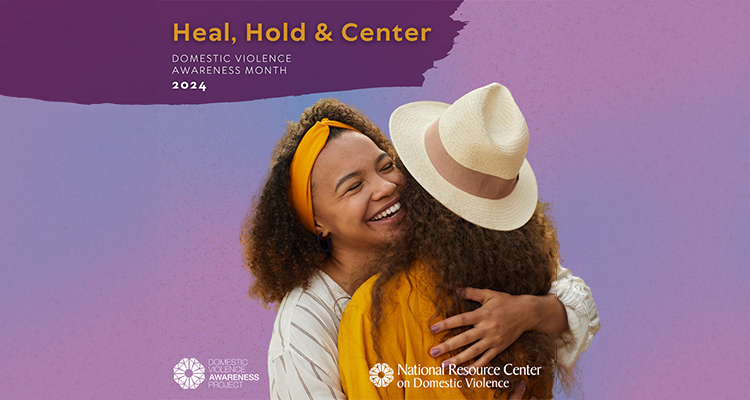Addressing the Gaps in Domestic Violence and Abuse: A Call to Mental Health Providers
October is Domestic Violence Awareness Month (DVAM), which was first observed in 1981 as a national “Day of Unity.” Over the years, it has evolved into a month-long event which unites advocates across the nation in hopes of ending domestic violence. This year’s theme, “Heal, Hold, and Center,” emphasizes the importance of healing from violence, creating space for survivors, and focusing attention on those who are most marginalized. In partnership with the Domestic Violence Awareness Project (DVAP), the 2024 DVAM theme invites everyone—advocates, providers, loved ones, supporters, and political leaders—to unite in raising awareness and amplifying the voices of survivors.
Domestic violence and abuse (DVA) are significant public health concerns with serious mental health implications for both men and women. Domestic Violence and Abuse (DVA) refers to a pattern of behaviors used by one partner to gain or maintain power and control over another in a domestic setting, encompassing various forms of violence and abuse—including physical, sexual, emotional, and financial abuse—that can affect intimate partners, family members, or individuals living in the same household, leading to severe consequences for victims and broader social implications.
In contrast, Intimate Partner Violence (IPV) specifically occurs between current or former romantic partners and involves behaviors such as physical, sexual, and emotional violence, which can result in serious physical and psychological harm to the victim. IPV affects nearly 12 million people each year, with 35.6% of women and 28.5% of men in the U.S. having experienced rape, physical violence, and/or stalking by an intimate partner at some point in their lives. It is estimated that 1 in 4 women and 1 in 5 men will experience IPV during their lifetime, resulting in severe health consequences, including the potential for death. Particularly concerning is that women of color and LGBTQ+ individuals face significantly higher rates of IPV, with some communities experiencing rates up to 2.7 times higher than those of White and heterosexual individuals.

Given the alarming prevalence and serious consequences of DVA, it is crucial to acknowledge how often it goes unaddressed in healthcare settings, resulting in unmet needs for both victims and perpetrators. For many years, screening for DVA was sporadic, causing health professionals to frequently miss opportunities to detect and address it in their patients. Studies indicate that direct inquiries from health professionals can significantly increase disclosures of abuse, particularly among individuals who may not seek help due to shame, fear, or a lack of understanding that their experiences qualify as abuse. Furthermore, evidence suggests that specific interventions—such as integrated DVA advocacy, direct referral pathways, and tailored training for mental health professionals—can lead to improved outcomes for victims. These interventions can help reduce the severity and frequency of abuse while enhancing quality of life and social inclusion.
Another challenge in effectively addressing DVA is that intervention programs for individuals who engage in abusive behaviors are often underfunded and ineffective. Federal funding for research into effective intimate partner violence (IPV) intervention strategies is severely lacking, and most existing programs are not supported by rigorous scientific evidence. For instance, only eight randomized controlled trials (RCTs) have examined IPV intervention programs, while over 300 RCTs have assessed interventions for Post-Traumatic Stress Disorder (PTSD). This neglect creates significant gaps in preventing future violence and ensuring the safety of survivors. Many existing IPV programs follow outdated models, such as the Duluth model or cognitive-behavioral therapy approaches, and show minimal impact in reducing recidivism, with studies revealing only a 5% reduction in repeat offenses, and some research indicating no significant impact at all. With over half a million individuals court-mandated into these programs annually, the potential harm of relying on ineffective methods is substantial. For mental health professionals, this raises a critical question: how can we truly help our clients if the systems in place fail to address the root causes of abusive behaviors?

To achieve meaningful progress in addressing DVA, we must work together to study, develop, and test new evidence-based interventions while challenging the status quo. Funding for more comprehensive research, particularly involving randomized controlled trials (RCTs), is crucial for discovering interventions that genuinely reduce violence. Promising approaches, such as mindfulness-based programs and trauma-informed strategies, have shown initial success in reducing IPV, offering hope for more effective treatments. However, these programs remain underutilized due to a lack of funding and institutional resistance to change.
Recognizing these challenges, mental health professionals must extend their role beyond merely supporting survivors; we must also advocate for systemic change in how DVA is addressed. Here are a few ways to get involved:

Advocate for Policy Change: Work with policymakers to broaden practice guidelines that prioritize scientific evidence over tradition. This can help shift resources toward programs that truly work.

Support Research Initiatives: Mental health providers can collaborate with researchers and community organizations to identify, evaluate, and implement promising DVA interventions.

Embrace Trauma-Informed Care: Recognize that many individuals who perpetrate DVA have experienced trauma themselves. Incorporating trauma-informed approaches can help address the underlying issues contributing to violent behavior.

Promote Evidence-Based Practices: Encourage the use of interventions backed by rigorous research. Question the effectiveness of programs currently in use and push for higher standards in treatment.
The principles of Heal, Hold, and Center align closely with the work therapists do to support victims of domestic violence. By taking a more active role in advocating for effective DVA interventions, mental health providers can help break the cycle of violence, promoting safety, healing, and healthier relationships. Domestic Violence Awareness Month is an opportunity to reflect on the gaps in current DVA intervention strategies and to push for change. Mental health providers are in a unique position to advocate for evidence-based, effective programs that address the root causes of DVA and offer hope for healing for both survivors and those who engage in abusive behaviors. The time for action is now. By standing together, DVAM strengthens efforts to promote awareness and advocate for decisive action to end domestic violence once and for all.
References
National Domestic Violence Hotline. (2024). Domestic Violence Awareness Month. https://www.thehotline.org/stakeholders/domestic-violence-awareness-month/
National Domestic Violence Hotline. (2024). Domestic violence statistics. https://www.thehotline.org/stakeholders/domestic-violence-statistics/
Taft, C. T., Murphy, C. M., MacDonell, K. W., Watkins, L. E., Creech, S. K., & Miller, M. M. (2024). Promoting the use of evidence-based practice for those who engage in intimate partner violence. American Journal of Preventive Medicine, 66(1), 189–192. https://www.ajpmonline.org/article/S0749-3797(23)00343-4/fulltext
Trevillion, K., Corker, E., Capron, L. E., & Oram, S. (2016). Improving mental health service responses to domestic violence and abuse. International Review of Psychiatry, 28(5), 423–432. https://doi.org/10.1080/09540261.2016.1201053
Blog Post Tags:
Related Blog Posts
Related Learning Labs
Related Resources
.
- Buscar Tratamiento de Calidad para Trastornos de uso de Sustancia (Finding Quality Treatment for Substance Use Disorders Spanish Version)
- Finding Quality Treatment for Substance Use Disorders
- Focus On Prevention: Strategies and Programs to Prevent Substance Use
- Monthly Variation in Substance Use Initiation Among Full-Time College Students
- The National Survey on Drug Use and Health (NSDUH) Report: Monthly Variation in Substance Use Initiation Among Adolescents









The DOI for your 3rd reference is incorrect.
Thank you for catching that. The correct reference has been updated.